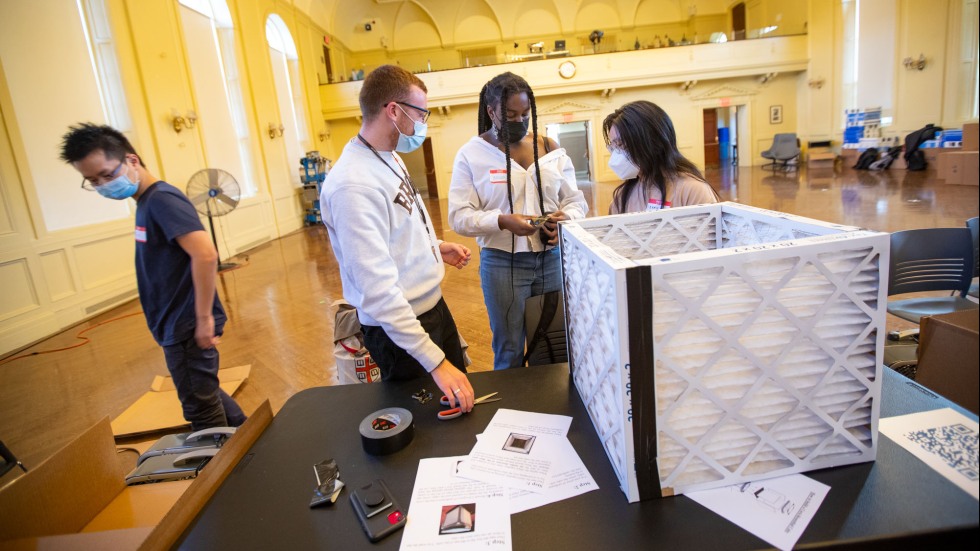PROVIDENCE, R.I. [Brown University] — Sure, free local pizza can be great — but what truly draws most Brown students to campus events is the opportunity to create, innovate and solve problems.
On a sunny Friday afternoon in late November, it was MERV 13 air filters that turned out a crowd at Alumnae Hall.
The School of Public Health lured students to a DIY building session with the promise of learning how to use four MERV 13 filters, plus a box fan, to quickly and easily assemble an inexpensive device powerful enough to filter out particles carrying the SARS-CoV-2 virus.
The air cleaner, called a Corsi-Rosenthal cube in honor of its inventors, is currently in use in classrooms and conference rooms in the School of Public Health as an additional measure to support interventions Brown put in place early in the COVID-19 pandemic to ensure optimal HVAC and filtration system operations.
“The Corsi-Rosenthal cubes are a great example of a public health intervention that can have an immediate impact on the school environment and our community’s overall health,” said Dr. Ashish Jha, dean of the School of Public Health.
Jha said that one purpose of the event was to get people talking about airborne viruses like COVID-19, understand the mechanisms by which they spread and see how measures like air cleaning can minimize risk. He also liked how the DIY nature of the cleaners gives people some control over their health.
“Teaching people how to build these boxes on their own shows them that they can actually improve the quality of the air in their public space, and that’s very empowering,” he said.
The students didn’t come just to learn — they rolled up their sleeves and rolled out some duct tape, which was really the main appeal.
“I saw this as a neat way to get hands-on,” said Ennie Zhu, a junior concentrating in public health. “You learn a lot in class, but you don’t always get to implement the things you learn. I wanted to say that I had a hand in doing something to help people stay healthy.”
During the event, groups of two or three community members, mostly undergraduates, stood ready to go at tables. After a brief demonstration, the newly trained builders got to work assembling the air cleaners.
The boxes are the brainchild of two environmental engineers — Jim Rosenthal of Air Relief Technologies and Richard Corsi, dean of engineering at University of California — who came up with them as an effective, low-cost way to remove air particles. In an interview during the pandemic, Corsi mentioned the concept of a portable air cleaner with walls made of filters; Rosenthal heard about it and built a version, and the two, who had worked together in the past, tweaked the design long-distance.
Unlike HEPA air filters, which can be expensive, materials for the cubes can be purchased at any hardware or big box store for around $120. When instructions were made available online, the idea of inexpensive DIY fan filters caught air. Over the past year, the open source design has been used extensively in schools, churches, homes and office buildings to remove particles like SARS-CoV-2 as well as smoke from wildfires.
At Zhu’s table was Noah Soutier, a Brown sophomore concentrating in public health. Soutier had been intrigued by how neither Corsi nor Rosenthal tried to patent the device, putting it out for the public good.
“It’s effective and also free and easy to build,” Soutier said. “When I heard about this opportunity to learn how to make one myself, I was like, why not?!”
Soutier, Zhu and sophomore Aaliya Battle are all enrolled in the same data analysis class. They agreed that the DIY-air cleaner workshop was a different, engaging way to learn about public health.
At another table, sophomore Johnny Chen said he was interested in learning how to build a working filter himself, with his own hands and some craft supplies, in under an hour.
It actually took much less time than that. Most groups assembled a cube in about 20 minutes.
Melina Tidwell Torres, a junior public health concentrator, was surprised at how fast and easy it was to assemble the box: “I’m interested in any way to get involved with public health, and this is a really cool DIY project,” she said.
In less than an hour, 15 fans were ready to be placed in various locations around campus, including the entrance to Brown’s COVID-19 test site at Alumnae Hall, the second level of the Granoff Center for the Creative Arts, and the lobby of the well-trafficked Salomon Hall. Just like at SPH, each will augment University’s existing efforts to keep the community healthy.
“There’s no such thing as air that’s too clean,” Jha said.
In addition, as part of the initiative, a team led by associate professor of epidemiology Joseph Braun will test the cubes’ efficacy at removing specific air pollutants and potentially toxic particles.
As the event came to a close, some of the students joined Jha and a member of the University’s Environmental Health and Safety team in rolling the ready-to-rumble fan-boxes out the door. The pizza boxes remained mostly unopened, the free slices unclaimed.



